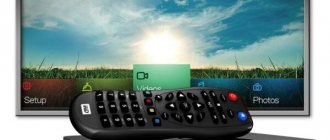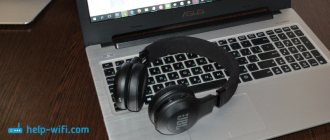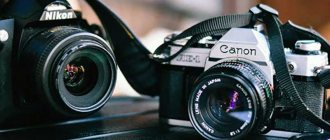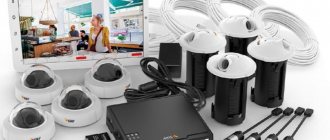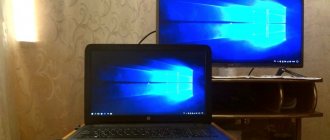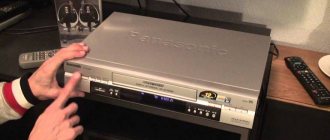Why buy a separate monitor device for the camera or turn on the computer every time in order to see who has come to visit you, when you can configure the connection of the video surveillance camera directly to the TV? If you hear the doorbell ring, just switch the TV to the desired channel using the remote control. Everything is very simple if you configure this connection correctly.
Content:
- 1 Features of modern web cameras
- 2 LG TVs
- 3 Samsung TVs
- 4 Sony Bravia TVs
- 5 Skype and smart TV
- 6 Best webcam models for connecting to Smart TV
- 7 Conclusions
Modern televisions have long gone beyond the scope of TV program repeaters. Their functionality allows you to access the World Wide Web and even communicate with friends and family through various instant messengers, including Skype. But before you can enjoy video communication, you will need to connect a webcam to your TV. In this article you will learn how to do this correctly and buy the right equipment.
Many users try to directly connect devices to each other. But it doesn't work. Because in addition to connecting the webcam to a smart TV, you need to turn on the messenger, go online and log into your profile.
Design features of video cameras
Mini video cameras can also be connected to a TV.
Depending on the design of the camera, there are:
- internal and external;
- dome;
- miniature.
In addition, all video cameras are divided into black and white, color, and mixed.
Internal and external
Indoor and outdoor CCTV cameras are designed for installation indoors or outdoors. At the same time, the internal ones do not have protection from external factors and are small in size and light in weight. External ones are mounted in special housings, allowing them to work in any climatic conditions and protect them from external factors (vandals, etc.). As a rule, external video cameras are installed far from the monitor, and therefore they must transmit the signal over long distances.
Box cameras, in turn, can be fixed or rotating. Indoors, the fixed ones are installed on brackets, and on the streets they are placed in a special thermal casing with heating and ventilation. If it is necessary to observe large areas, they are equipped with wide-format lenses with a zoom lens.
Video cameras equipped with a rotating mechanism can change the surveillance area at certain intervals according to a preset program.
Dome cameras
The dome camera has a 360 degree view.
Dome cameras have an attractive appearance and can be installed both indoors and outdoors. They differ from other types by the presence of a high-speed rotating mechanism, which can move the zoom lens both vertically (180°) and horizontally (360°), allowing you to control areas with fast-moving objects.
Mini cameras
Mini cameras are used for covert surveillance, for which they are hidden, for example, in interior items in such a way that the device cannot be noticed. The lens is no larger than the eye of a needle, and therefore the observation area is limited to a small size.
The matrix of black-and-white cameras has high photosensitivity and high resolution, which allows them to be used where a detailed picture is needed. Color provides detailed transmission of a color video image, which makes the image on the screen more informative. Mixed cameras have the ability to change color depending on the time of day. At the same time, high-quality night photography is carried out using IR illumination.
Features of modern web cameras
Manufacturers of this equipment strive to take into account all possible places and ways of using them. Advanced technologies are used in development. For example, the light sensitivity of such devices is much better, which allows you to communicate with your interlocutor in a room with any lighting.
In addition, the cameras use multiple noise-cancelling microphones. This allows you to be at a distance from the TV without the risk of not being heard by your interlocutor.
Why did such a need arise at all? The fact is that the diagonal size of modern televisions is much wider than the screen of personal computers and laptops. Connecting a webcam to a smart TV allows the whole family to communicate. Plus, unlike built-in cameras in laptops, external devices are technically much more efficient.
So how do you connect your camera and TV?
The image from the video camera can be displayed on the screen of a regular home TV, and in real time you can watch what is happening, for example, in the yard. To organize such a system you will need a video camera, a power supply for it, connectors for connections, a small mounting box and several meters of cable.
Choosing a place to mount a video camera
First of all, you need to choose a location to install the camera. It must be placed so that the object of observation is in most of the frame (scene). When installing, it is worth considering, for example, trees whose foliage will interfere with the view. In addition, direct rays of the sun should not enter the camera lens - due to light exposure, the picture will be unclear. The same goes for lighting fixtures.
When purchasing a video camera, check the specifications of the model. Typically, the viewing angle varies in the range of 70-100 degrees, but there are cameras with an angle of 40 degrees, which may not be enough for full observation of the object. In most cases, 70 degrees is enough.
Where exactly to connect to the TV?
Let's consider the simplest and most inexpensive solution - an analog camera connected to the TV via an AV (composite) input. All modern TVs are equipped with a similar input. If your TV is an older model, it may have a SCART connector instead of an AV connector. In this case, you can use a SCART-AV adapter.
Composite AV TV input
To connect, we will use an RG6 coaxial cable (this is the one that is usually used when installing television antennas). It will send a picture from the camera to the TV. To supply power to the camera, we use a 1-amp switching power supply and an electrical cable. Considering that we are talking about 12 volts, then if the distance does not exceed 15-25 m, even a ball screw with a cross-section of 0.5 will be sufficient. If the distance is greater, then it is better to buy a cross-section of 0.75, since drawdowns in current strength are possible.
The installation process itself boils down to pulling cables from the TV to the camera itself. We fasten the cables together with plastic clamps. What to attach to the wall - choose for yourself. Any hardware/construction store will offer you several options for fasteners.
We attach a mounting box near the camera: we will hide the connectors in it. When inserting the camera cables and connectors into the box, try to make sure that they enter from the bottom - with this approach, in inclement weather, water will not flow into the box through the cables. It is recommended that the place where the cable enters the camera body be sealed with silicone. Typically, video equipment manufacturers do this at the factory, but there are cases when the camera fails due to moisture.
Mounting box with cables routed to the bottom
We use a BNC connector to connect the camera to the coaxial cable. They come in different forms, but it is recommended to use them with a bolt or clamp. Such connectors have shown more stable operation, and unlike those that are screwed on, they do not create problems over time due to the fact that the cables shrink and contact is lost.
Connecting a BNC connector to a coaxial cable
We install the power connector on the ShVVP cable (the connector can be cut off from our power supply), after which we insulate all metal parts of the connectors with electrical tape.
On the TV side, we install a “tulip” connector on the coaxial cable (they also come with a clamp), and connect the power cable to the power supply.
On the TV remote control we select the AV input and see the picture from our video camera. By the way, in most cases, TVs are equipped with two or even three AV inputs. Accordingly, you can connect several cameras, one for each input. Such a video system will allow you to see in a matter of seconds (by clicking the remote control) who has approached the door or is hanging around your car in the yard. If necessary, four video cameras can be connected to the so-called “quadrator” - a small device that connects to the TV and divides the screen into four parts, each of which contains a picture from a video camera, but this device is considered outdated, besides, anyone can do the same DVR.
IP and HD cameras
Connecting IP and high-definition cameras to a TV is only possible through an intermediate device. In the case of TVI / HDCVI / AHD, such a device will only be a DVR (not counting models equipped with a switch to analog video mode). It is worth noting that the recorders are equipped with different video outputs - HDMI, VGA, composite (“tulip”). Accordingly, it can be connected to a TV or computer monitor, which is preferable since it supports high-definition video (FullHD and higher), while TVs with this option are quite expensive.
IP cameras are more versatile. You can connect not only a network video recorder to the TV, but also a laptop or PC, to which the image from the IP camera will be broadcast using special software.
LG TVs
Web cameras for LG Smart TVs come with special magnets for mounting. They do not spoil the appearance of the TV and do not require any installation skills. After this, the webcam is connected directly to the TV via a USB interface. You can install the camera not on a TV. This will not affect functionality in any way. Its placement is purely a matter of taste. Web cameras have fairly long wires, which allows them to be placed in any convenient place.
After you have connected the camera to the Smart TV, you need to launch the messenger program. She will set all the settings on her own. By the way, there is a manual adjustment mode, but if you do not have experience, it is better to trust the software. Once everything is ready, you can take photos, record videos, or chat with your buddies via the messaging app.
Procedure
Often, not only external video surveillance is connected to the TV, but also web cameras and systems for monitoring what is happening inside the apartment. In the first case, if there is a Smart TV, the panel turns into a multimedia center with the ability to video communicate with loved ones, record video blogs, stream broadcasts, and games. To use an analog card, you will need a serial connection through a personal computer that has a tulip-type input.
Direct connection is only possible with a camera that has an Ethernet card. Such cameras have high detail, a built-in microphone, and special effects can be added to the video sequence. Before connecting, make sure:
- the TV has the necessary connector that supports a digital interface;
- A cable is available for connecting devices into a single system.
To successfully start the system:
- connect Ethernet to the input;
- set up an Internet connection using the instructions;
- open the application;
- select the signal source.
To organize collective video surveillance, in order to save money, you can not buy several new cameras, but use one, together with a signal modulator. The diagram for such a connection will look like this:
- a break is made in the television cable where the modulator will be installed. It is fashionable to make a point both within the apartment and on the staircase;
- the modulator adds an additional channel with a free frequency to the stream, allowing the broadcast to be divided;
- Next, set your preferred broadcast frequency.
Using a signal divider you can display the image on four different TVs.
For old cameras that need to be connected to a new TV, you will need to purchase a special converter that converts the format of the transmitted signal. The system is created using a coaxial cable, which is crimped on both sides with BNC connectors. One side is output to the output located on the camera, and the other is installed in the “Input” socket on the converter, which in turn is connected to the TV panel using a VGA cable.
Samsung TVs
The procedure for connecting a webcam for Samsung Smart TVs is not much different from the instructions described above. The fact is that such devices are universal and suitable for various TV models.
If you are planning to connect a webcam to a Samsung Smart TV, you have two options - installation on the device itself or in any convenient place. In the first case, you need to use a special magnetic holder. It does not damage the appearance of the case and does not require additional tools.
Next, using a USB cable, the camera is connected to the TV through the appropriate interface. Finally, you can turn on the TV and set up the messenger program. Once completed, you will be able to take photos, shoot videos, and participate in video calls.
Other ways to connect analog cameras
In addition to the above, there are also less common methods of using non-digital video cameras. One such method is through connections through an old VCR, most of which were capable of outputting images from various devices. The disadvantages of this method are obvious. Firstly, few people still have a live VCR. Secondly, they have not been sold in stores for more than ten years. For these reasons, only a few "lucky" people will be able to connect the camera in this way. Another disadvantage of this connection is that it records exclusively on old magnetic cassettes, which are very difficult to find these days.
Therefore, using a video cassette recorder is not suitable for almost anyone nowadays, and almost all newer DVD players do not have the ability to connect an analog camera (or there is no disc recording function). It is completely impossible to connect any analog devices to modern players from flash drives using standard methods (such players can only work with digital IP cameras).
"Underwater rocks"
The first difficulty that you may encounter in the process of organizing such video surveillance is the number of wires that will have to be installed. If in a digital video camera power supply, video signal transmission and control of the rotating mechanism are carried out through one wire (PoE technology), for an analog one, you will have to use three cables (with very rare exceptions). It is not always possible to conveniently lay one single cable; it’s not worth talking about three.
It is also very desirable to have an outlet or power supply near the video camera, from which the device will operate. While a digital camera can receive power directly from a DVR, router or computer via PPoE, analog devices do not support such technology (for obvious reasons).
The length and quality of the cable in non-digital video surveillance systems affect the video quality much more than in digital cameras. Therefore, if you use a cable that is too long and of poor quality, severe noise or distortion may appear in the image received from the camera.
Main connectors for connection
One of the most popular connectors is RCA (in simple language “tulips”). This type of connection is distinguished by good video transmission quality and minimal interference, which is why it is quite widespread.
There are also video cameras with the ability to connect to input F (antenna). Their advantage is the ability to connect to almost anything (even an old Soviet TV). The disadvantages are the frankly poor quality of the transmitted video and noticeable interference, so they prefer not to use the antenna input, connecting the device using “tulips” (which is often even cheaper).
conclusions
Despite the rapid obsolescence and emergence of more advanced technologies, analog video surveillance is still widely used in homes or at various facilities. Not everyone wants to change a time-tested video surveillance system to a newer one, especially considering the huge costs of such an upgrade.
Connecting analog cameras is not as difficult as it might initially seem. The main thing is to choose the right equipment (for analog cameras you should buy a DVR with analog inputs), with the rest everything is extremely simple. It is enough to connect the cameras to the appropriate inputs in the DVR, TV or computer video capture card.
Although in some cases problems may arise (in particular when trying to connect analog video cameras to exclusively digital devices). But even in such situations it is not difficult to find solutions, because there are many converters or other devices that allow you to make switching.
Other articles:
- Basic principles when designing a video surveillance system
- Panoramic IP camera 360 degrees
- Video surveillance in the office
- IP camera with motion sensor and recording
Sony Bravia TVs
The devices of this manufacturer are quite popular due to their relatively inexpensive price and high quality. At the same time, to connect a web camera to TVs of this brand, all the same steps will be required as in the cases described above.
First, you need to turn off the TV and install a webcam on it. This is done using a special magnetic holder. If desired, you can install the webcam in any other place (within reach of the cable). If the wire is not enough, you can buy special USB adapters separately.
After installing the web camera, you need to connect it to the USB connector and, after turning on the TV, launch the messaging program. The application will configure the system and from that moment you will be able to use the camera. As you can see, the procedure is no different from connecting a webcam to Samsung Smart TV and LG Smart TV.
Necessary materials and tools for connection
If you decide to set up signal transmission from a video camera to a TV, you will need the following materials:
- Power unit;
- Connecting cables for connecting the DVR, possibly additional adapters if the connectors on the TV and camera are different.
In order for the video camera to operate, it needs power. The output voltage of the power supply must be rectified and stabilized in the range from 9 to 15 volts (the most common power supply parameter is 12V). And the maximum current is not less than 0.1 ampere (preferably 0.7-1A).
Each camera has its own power needs, so the power supply must be selected according to the marking: for example, most often devices are marked as follows: 9-15V DC/0.1A. That is, you will need a power supply of 9-15V and with a current of 0.1A.
If several recorders are connected to one power supply unit, then the last parameter is summed up: for two cameras the current should be from 0.2A, for three – from 0.3A, etc. The voltage remains the same - 9-15V.
The cables that can be used to connect a camcorder to a TV can be of five types:
- Coaxial;
- "Tulips";
- S-video;
- SCART;
- HDMI or Mini-HDMI.
Coaxial cable is a familiar wire that is used to connect an antenna to a TV. “Tulips” is an RCA jack, or composite cable, this standard is widely used in audio and video equipment. Its plugs and sockets are painted in different colors, which greatly helps you navigate when connecting the wire.
The S-video cable is not very common, although it perfectly transmits digital images without loss of quality. SCART connectors are a fairly common European connection format for television equipment, which cannot be confused with anything else: its plug is a metal box with 21 pins.
Well, the HDMI cable is considered the leader of all digital technologies. It is capable of sending video signals and multi-channel audio digitally without conversion.
The most popular cable for connecting a video camera to a TV is considered to be AV RCA, in which one end is an AV 3.5 mm input plug, and at the opposite end there are three tulip output plugs. The efficiency of the transmitted image very much depends on the quality of the connecting wires.
Skype and smart TV
The most popular messenger today is Skype. However, in 2021, the app developer stopped supporting some operating systems such as webos. This means that you will not be able to officially download the application. However, this does not mean that you will not be able to work with the messenger.
There is a way to solve this problem. You need to download the distribution kit from the Internet (it is in an archive, so before installation, you need to unzip it on your PC). Next, transfer it to the TV via a USB flash drive. This scheme works for both LG and Samsung.
After downloading the data to the flash drive, you need to insert it into the TV connector and install it on the page with additional devices. However, after some time this method may become unavailable, since Skype plans to completely abandon support for devices on certain OSes.
If the described solution does not work for you, there remains a reliable and proven option - connecting the TV to a computer or laptop. In this case, the screen can be used like a regular monitor, only with a much larger diagonal. At the same time, if you already have Skype installed on your PC, you can easily use it with a webcam connected to your Smart TV.
Transfer images from multiple cameras to TV
If you want to watch images from not one, but from several surveillance cameras on several separate TVs, then you will need a more complex device - an IP video recorder, or media server. It is capable of transmitting high-quality images to an unlimited number of TVs, and if the device supports wireless transmission via Wi-Fi, the signal can even be distributed to mobile devices.
You can set up a broadcast from street CCTV cameras to TVs via a media server according to the following scheme:
- First of all, we connect the IP video recorder to the TV receiver via an HDMI cable.
- From the free Google Play resource, download a special program from the video device manufacturer and install the downloaded application on your media center.
- Launch the program on the IP video recorder and set the signal reception from the camera.
Further control of the software product will be carried out through TVs: you will need to find a transmission channel and configure your video surveillance scheme. The process may not be entirely easy and immediately understandable, but once you understand it, you will create a convenient and reliable video surveillance system on all the necessary devices.
The best webcam models for connecting to Smart TV
Not all web cameras that are on the market today give good results when connected to a Smart TV. And not everyone is suitable. IP cameras, for example, cannot be used for these purposes.
If you choose the wrong device, the picture and sound quality will not meet your expectations. Therefore, we offer a list of technical characteristics that you should pay attention to first when choosing a device:
- Matrix.
- Screen resolution.
- Image transmission frequency.
- Sound quality through built-in speakers.
Well-known TV manufacturers offer their video cameras that are optimally suited for their model range. Such devices include the LG AN-VC400 web camera. This camera has a two-megapixel matrix and a screen resolution of 1200 by 780. At the same time, the camera image transmission rate for the LG Smart TV is 30 frames per second. The webcam has a built-in high-quality microphone. The weight of the device is only 78g. Such a model could completely replace a CCTV camera.
The well-known manufacturer Samsung also offers its own model of web cameras for TVs. The web camera of the CY-STC1100 model is practically no different in its technical characteristics from the web camera version described above for an LG TV. However, the difference is that Samsung additionally builds in four microphones to improve sound transmission. You can buy such a camera in various online stores.
In addition to this model of web camera for Samsung TV, you can pay attention to the VG-STC3000/RU. It has an HD 720p matrix. Video transmission speed is 30 frames per second. The device has 4 microphones to improve sound quality. There is a noise reduction system.
In addition to the camera itself for a Samsung Smart TV, such devices allow you to use the gesture control function, which became available on Samsung TVs in 2013.
In addition to the devices listed above, the market also offers universal web cameras that are supported by all TVs. It was developed by the famous manufacturer Logitech and appeared back in 2012. The connection is made via a regular HDMI cable. A special control panel is supplied with the device. The model is equipped with a wide-angle lens and four microphones. A noise reduction system has been introduced. The device has its own power supply and ringer, which allows you to receive incoming calls even when the TV is turned off.
Selecting a camera or video surveillance system
Recent advances in video surveillance technology are allowing more people to build their own video surveillance systems. The use of so-called "nanny cams" helps to monitor our children, explore the outside perimeter of the house from the inside, and monitor any workers inside the house.
Cameras vary in size and recommended use, but the basic function remains the same: the device must be connected to a monitor or TV. Let's get acquainted with the main criteria when choosing a camera or video surveillance system.
First of all, if you organize a video surveillance system via a TV, you should pay attention to the technical capabilities of the latter:
- What is the size and format of the television screen;
- What type of signal can it receive;
- Indicators of scanning frequency and screen response time;
- Does the TV support smart TV?
The following four characteristics are important for a camera:
- Lens viewing angle;
- Focal length;
- Matrix resolution;
- Photosensitivity.
It is wrong to think that for a high-quality video surveillance system, only good camera resolution is important. The image output device also plays a significant role. If you buy an expensive video camera model, but connect it to a simple and small screen, you will get a blurry and unclear image that you will have to look closely at to make out what is happening at the object of observation.
The size of the TV must be chosen depending on the size of the room in which it will be installed. There is such a convenient formula with which it is easy to determine the optimal distance from the TV receiver depending on the size of its screen. It's called "Five Diagonals".
That is, if you buy a TV with a diagonal of 40 inches (or 102 cm), then it is better to watch it at a distance of 5 * 102 = 5 meters and 10 centimeters. By back-calculating, you can find out what size TV you should buy for your room.
When it comes to screen format, the choice is very simple: almost all the latest plasma and LCD flat-screen TVs, as well as most video projectors designed for home cinema, are produced in widescreen format, which means they have a 16*9 display aspect ratio.
The sixteen by nine aspect ratio, also known as high definition (HD), has become the leading aspect ratio since the beginning of the 21st century. This is the international standard for HDTV, non-HD digital television and PALplus widescreen analogue television. Standard television, which has existed since the mid-50s and has an aspect ratio of 4:3, is confidently becoming a thing of the past.
Different TVs can receive different types of signals:
- Analog – PAL, SECAM, NTSC;
- Digital – DVB.
You will not be able to use high definition analog cameras with HD-TVI, HD-CVI and AHD technologies as they are not compatible with your TV. A standard analog CCTV camera that can be connected to a TV uses Composite Video Baseband Signal (CVBS) technology.
Analog signals are significantly inferior in image quality and stability to the digital channel. Therefore, if possible, it is worth buying both a camera with the ability to capture video in digital format and a TV capable of receiving a DVB signal.
There is another new type of video surveillance device - an IP camera. IP stands for Internet Protocol, which now refers to a digital video camera that can send and receive data over a computer network, as opposed to sending a feed to a digital video recorder (DVR).
Megapixel IP cameras capture a much wider field of view than comparable analog cameras, meaning that one IP camera can potentially do the work of three or four legacy cameras. Today such web devices are available in 1.3-; 2- or 3-megapixel configuration.
The scan frequency and screen response time are two parameters that determine the quality of the picture on the screen. The first value indicates the screen refresh rate (frames per second). The higher the scanning frequency of the TV, the clearer the image will be; the minimum value for comfortable viewing is 85 Hz.
Response time is a measure of how quickly pixels can change their state: from active to passive or vice versa. The smaller the number of milliseconds, the faster the screen will update the picture, this is especially important in dynamic scenes of films or games. The best response time today is 0.002 ms.
Now let's explain the main characteristics of video cameras. The viewing angle of the lens is a parameter responsible for the coverage of space. This is the angle of the subject area that is projected onto the camera sensor by the lens. In simple terms, this is the angle at which the sensor can “see” through the lens.
The focal length of a lens is the distance in millimeters between the sensor and the optical center of the lens. This parameter is not measured from the sensor to the front element of the lens, but is the point at which light rays intersect and are directed towards the sensor.
If you hear the term “wide-angle video camera,” this is what they call lenses with focal lengths of 3.6 mm or less. Such devices will be able to perfectly survey a wide area, but the detail in them will not be at the highest level. For example, if the visitor’s face or an object in his hand must be clearly visible on the camera, then it is worth installing a video camera with a focal length of about 16 mm.
A camera's light sensitivity is measured in units called LUX. The higher the number, the more light is needed to capture images. Cameras that have a very low LUX value, close to zero, are capable of collecting images in almost any lighting. If the area is bright and constantly changing, an auto iris lens is needed to get the best image. Manual or fixed iris lens is compatible with areas where light output remains constant.
The camera's image quality will be measured in TVL, or TV Line Resolution. A larger TVL will result in more lines of resolution and the image quality will be much sharper. Standard camera size ranges from 380 TVL to 420 TVL, high quality – from 480 TVL to 570 TVL.
The best camera to connect to your TV will be the one that best suits your application environment. If you need to record the finest details, consider purchasing a camera with a high TVL. An infrared camera is required to record images at night or in low light. If you need a large space to save time, a device with a wide viewing angle will be a priority.
conclusions
Connecting a webcam to a TV is not difficult. It will only take a couple of minutes and does not require any special skills. Modern TVs market their own web cameras, unique to each brand. Moreover, the price for them may vary depending on the technical characteristics. They are distinguished by high quality of both image and sound transmission. They use the device not only for messengers, but also as a camera or video camera, for example. However, there are also universal models that are suitable for TVs of any brand.
Found a mistake? Select it and press ctrl+enter
- 60
Functionality check
The settings can be checked using the specialized resource portscan.ru. If the ports were open and forwarded by the router to the virtual server, then the software will show a successful connection.
The remote PC is allowed to use ActiveX. The IP address for the router is entered into the address bar of the browser and the value of port 81 is added. If during setup of the recorder a connection to the Internet is not established, then you can use the binding of the DNS address of the router directly to the camera. Qualitative testing of the system is required due to the possible blocking of some ports by providers.
To check the correctness of the recording and the serviceability of the motion sensors, an observation lasting several days is carried out. It is better to entrust testing to specialists from the service center.
Additional customization may include:
- debugging software compatibility for sending data between components;
- optimization of throughput parameters;
- allocation of a separate network for the system when segmenting the LAN network;
- setting cleaning rules, depending on the memory size and shooting frequency;
- optimization of router parameters;
- prioritization principles for cameras;
- appointment of a network administrator;
- setting up software to prevent virus attacks and illegal access.
The number of items varies depending on the tasks required and the complexity of the equipment.
Connection via RCA
If there is no advanced modification of the TV, you can use a device that has an RCA signal connection interface. You can also connect a CCTV camera to such a device.
Most IP cameras transmit signal using a BNC connector. Accordingly, it is necessary to ensure a transition from one signal to another. To do this, you will need to purchase two connectors: a regular tulip-shaped connector and a male connector for the BNC. They can be connected using a coaxial cable with a resistance of 75 ohms. After connecting the adapter on both sides to the video camera and TV, you can configure the input signal. This is usually done in AV or Composite mode.



